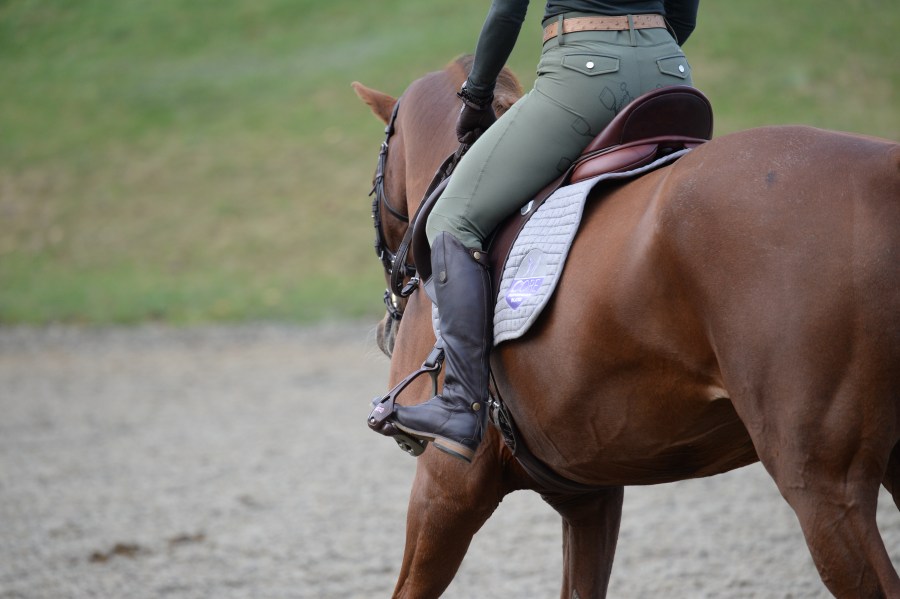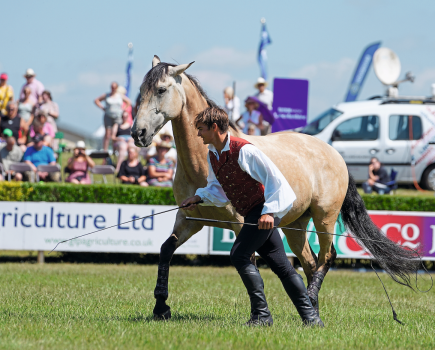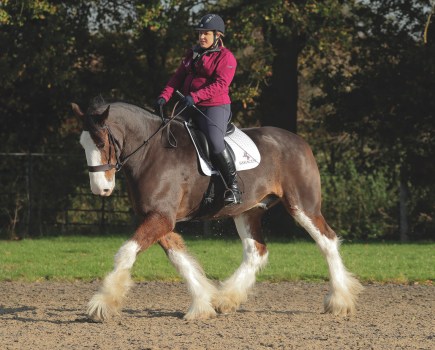Do you ever feel like everything’s going really well in a schooling session, until you ask your horse to change the pace and they start hollowing in transitions?
Sometimes you switch gaits and it feels like all your hard work is undone. I know because I’ve been there — and myriad other riders have too. However, you can train your horse — and yourself — out of hollowing in transitions.
“A horse hollows — or, in simple terms, lifts their head and falls onto the forehand — when they are not connected to the bridle,” explains international dressage rider Emile Faurie, who has represented Great Britain at the Olympics and World and European Championships.
“This is commonly seen in transitions when balance is lost and your horse drops back, shifts their weight to their shoulders and lifts their neck.”
The best way to tackle hollowing in transitions is going back to basics and working on having them on the bit and connected into the rein.
“If your horse is pushing through from their hindquarters, working over their back and giving the feeling that they’re pushing into the bridle then, theoretically, they shouldn’t hollow,” says Emile.
Thankfully, there are a number of exercises you can try to help harness this feeling, which Emile explains below.
Exercise 1
Ride a progressive downward transition
“When a downward transition is technically correct, the horse seeks the bridle and won’t come above the bit,” says Emile. “Making the transition progressive will help you achieve this.”
Learn to do this using the following exercise:
- Begin with trot-walk transitions.
- To prepare for the downward transition, slow your horse’s trot steps with your rise and encourage them to drop their neck with gentle rein aids.
- Once your horse is taking much smaller and slower steps, encourage a forward walk transition with your lower leg on their sides.
“Slowing the horse progressively helps you maintain your balance and lower leg position, which in turn helps the horse keep their core engaged and back lifted,” explains Emile. “You can use this exercise to perfect trot-halt transitions too.”
Exercise 2
Spiral in to a downward transition
According to Emile, a common cause of hollowing in transitions is the horse losing softness and submission as they make a downward change in pace. To improve this, incorporate the following exercise in your regular training sessions:
- Begin trotting on a 20m circle, remembering you barely need your horse to bend their neck to the inside — too much and they will fall out through the outside shoulder.
- Focus instead on using your rein aids with a supportive leg to establish inside poll flexion and suppleness, and security in the outside rein. This will create a correct bend through the horse’s body to make a circle.
- Spiral in to a 10m circle while keeping that feeling of outside rein connection and flexion rather than bend.
- A 10m circle is naturally collecting for a horse, so you will need to ride forward to maintain your horse’s frame and rhythm.
- Then, keeping soft in your position with your leg supporting, ask for the downward transition to walk.
Exercise 3
Improve your trot-canter transitions
Perhaps you find hollowing is a particular issue when asking your horse to pick up canter. As in the previous exercise, begin trotting on a 20m circle and spiralling into a 10m circle. Then, maintaining inside flexion, place your inside leg behind the girth as you ask your horse to leg-yield back onto a 20m circle.
“This will encourage the horse to lift their back and further establish your outside rein connection.” explains Emile. “Then, as you ask for canter on reaching 20m, make your outside leg aid much clearer.”
Exercise 4
Solve any resistance to a contact
Every transition — even a downward one — is a forward movement in which a horse must remain connected. Don’t think of it as ‘slowing down’ to walk, as this is a backwards movement. Say (and think) “forward to walk” instead.
“When a horse hollows, a common rider error is tightening through the forearm and locking the hands,” Emile says.
“Your hands should never be static and there should always be a sense of elasticity in the reins. Stay relaxed and give with the hands as your horse moves forward through a transition, just as you do when trotting up the long side of an arena.”
Exercise 5
Get your horse is working forward
Hollowing in transitions is a sign that your horse isn’t forward, so teach them that moving off your leg is enjoyable — especially if they’re a stuffier sort.
“After picking up canter, give the horse a strong leg aid and get out of the saddle for a few strides. As you do this, soften your hand to praise them,” advises Emile, a list two British Dressage judge who founded The Emile Faurie Foundation to introduce disadvantaged children to horses and riding in 2006.
“Sit back down and, when the horse comes back to you, get off their back again and send them forward. The horse will soon find the fun in moving off your leg.”
Emile’s top tip for riding transitions
If hollowing in transitions is a problem for you and your horse, then you need to focus on establishing and maintaining a good elastic contact first.
“Aim to feel your horse pushing into the reins, but think of it as pressing into the browband,” says Emile. “This is a truer reflection of working ‘on the bit’ and helps to avoid burying the horse’s poll which in turn leads to them leaning on the hand.”
Main image (stock) © Your Horse Library/Kelsey Media










